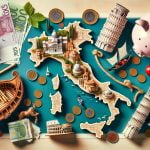Traveling to Italy is a dream for many, with its rich history, stunning architecture, and delectable cuisine. But the question remains: is travel to Italy expensive? In this article, we will explore what to expect when traveling to Italy and provide tips on how to make the most of your trip without breaking the bank.
When planning a trip to Italy, one of the first considerations is the cost of airfare. We’ll discuss tips for saving money on flights, as well as accommodation options in Italy – from budget-friendly stays to luxurious experiences. Additionally, we’ll delve into the world of Italian cuisine, comparing dining on a budget to fine dining experiences and exploring transportation options within Italy, such as trains, buses, and rental cars.
We’ll also cover entrance fees to Italian tourist attractions and highlight hidden costs of traveling in Italy – such as tipping, taxes, and service charges. Lastly, we’ll provide budgeting tips for traveling to Italy and offer final thoughts and recommendations for budget-conscious travelers. So if you’re wondering whether a trip to Italy is within reach, read on for valuable insights.
Cost of Airfare to Italy
When considering travel to Italy, one of the major expenses to budget for is the cost of airfare. Depending on where you are traveling from and the time of year, airfare to Italy can vary greatly in price. Generally, flying to Italy from within Europe will be less expensive than flying from North America or other parts of the world.
It is important to book your flights well in advance and be flexible with your travel dates in order to find the best deals. Additionally, consider using flight comparison websites and signing up for airline newsletters to stay informed about any flash sales or special promotions.
Another way to save money on flights to Italy is by being open to alternative airports. For example, flying into a smaller airport near your destination city could potentially save you money compared to landing at a major international airport. Keep in mind that indirect flights with layovers may also offer significant savings, so be sure to explore all options when booking your airfare.
Additionally, consider taking advantage of travel rewards programs and credit card points that can be used towards airfare. Many credit cards offer sign-up bonuses that include points or vouchers for free flights, which can help offset the cost of traveling to Italy.
Finally, consider traveling during off-peak seasons and avoiding major holidays, as airfare prices tend to spike during these times. Being flexible with your travel plans and diligent in searching for deals can greatly reduce the overall cost of flying to Italy.
| Aspect | Tip |
|---|---|
| Book in advance | Plan ahead and book early |
| Be flexible with dates | Consider different travel dates |
| Consider alternative airports | Look into smaller airports nearby |
| Use travel rewards programs | Utilize points and vouchers for flights |
Accommodation Options in Italy
When considering a trip to Italy, one of the most important factors to account for is the cost of accommodations. Depending on your travel preferences and budget, Italy offers a wide range of options for lodging, from budget-friendly hostels to luxurious hotels and villas. The type of accommodation you choose can greatly impact the overall cost of your trip.
For budget-conscious travelers, hostels and guesthouses are excellent options for finding affordable accommodations in Italy. These types of lodgings offer basic amenities and shared living spaces at a fraction of the cost of traditional hotels. Additionally, many hostels provide communal kitchens, allowing guests to save money by preparing their own meals.
On the other hand, travelers looking for a more lavish experience can opt for luxurious stays in Italy’s upscale hotels, resorts, and villas. While these accommodations come with a higher price tag, they often offer top-tier amenities, breathtaking views, and exceptional service that cater to those seeking a more indulgent experience.
It’s essential to consider your accommodation preferences when planning your trip to Italy. By weighing the advantages and disadvantages of budget-friendly versus luxurious stays, you can make an informed decision that aligns with your travel goals and financial resources.
| Accommodation Type | Key Features |
|---|---|
| Hostels/Guesthouses | Affordable rates, shared living spaces, communal kitchens |
| Luxurious Hotels/Resorts/Villas | Top-tier amenities, breathtaking views, exceptional service |
Exploring Italian Cuisine
When traveling to Italy, one of the highlights for many tourists is the incredible cuisine that the country has to offer. From pizza and pasta to gelato and espresso, there is no shortage of delicious food to indulge in. However, the cost of dining in Italy can vary significantly depending on where and how you choose to eat.
If you’re looking to stick to a budget while still enjoying authentic Italian cuisine, there are plenty of options available. Consider visiting local markets and grocery stores to pick up fresh ingredients for a picnic in a scenic park or along the coastline.
Additionally, many cities and towns have small family-owned trattorias where you can enjoy a homemade meal at a reasonable price. Street food is also a great way to experience Italian cuisine without breaking the bank, with options like arancini, panini, and porchetta sandwiches available from vendors throughout the country.
On the other hand, if you’re interested in experiencing fine dining during your trip to Italy, there are countless Michelin-starred restaurants and upscale eateries to choose from. This level of dining typically comes with a higher price tag but offers an unforgettable culinary experience with top-notch service. Keep in mind that these establishments often require reservations well in advance, so be sure to plan accordingly if this is something you’d like to include in your itinerary.
Ultimately, whether you opt for budget-friendly dining or luxurious fine dining experiences during your travels in Italy will depend on your personal preferences and how much you’re willing to spend on food. No matter which route you choose, the opportunity to savor authentic Italian dishes amidst the stunning backdrop of this beautiful country is an experience not to be missed.
Transportation Within Italy
When considering the cost of traveling to Italy, one major factor to keep in mind is the cost of transportation within the country. Whether you’re exploring the bustling cities or venturing into the picturesque countryside, you’ll need to consider the different options for getting around. The good news is that there are various transportation options available, each with its own cost considerations.
One popular mode of transportation in Italy is taking trains. The country has an extensive and efficient railway system that connects major cities and regions. Traveling by train in Italy can be a convenient and economical option, especially if you book your tickets in advance. Additionally, traveling by train allows passengers to enjoy scenic views of the Italian landscape during their journey.
Another transportation option to consider is taking buses. While buses may not be as fast as trains, they are often a more budget-friendly mode of transport, particularly for reaching destinations that may not be easily accessible by train. Many cities and towns in Italy have well-developed bus networks, making it a viable option for travelers looking to explore off-the-beaten-path locations.
For those who prefer more flexibility and independence in their travels, renting a car is an option worth considering. While renting a car may offer convenience, it’s important to factor in additional costs such as fuel, parking fees, and tolls. However, having your own vehicle gives you the freedom to explore remote areas at your own pace.
Whether you choose to travel by train, bus, or rental car ultimately depends on your budget and travel preferences. Each option has its own advantages and drawbacks when it comes to cost, convenience, and accessibility. By comparing these different transportation modes, travelers can make informed decisions based on their needs and priorities while exploring beautiful Italy.
Entrance Fees to Italian Tourist Attractions
When planning a trip to Italy, one of the things that travelers need to consider is the cost of entrance fees to Italian tourist attractions. Italy is home to some of the world’s most iconic landmarks and historic sites, and visiting these attractions is often a highlight of any trip to the country. However, these entrance fees can add up quickly, especially for budget-conscious travelers.
Popular Tourist Attractions
Italy is filled with famous tourist attractions such as the Colosseum in Rome, the Uffizi Gallery in Florence, and the Leaning Tower of Pisa. Each of these attractions charges an entrance fee for visitors, and these fees can vary depending on factors such as age, student status, or whether visitors purchase tickets in advance. It’s important for travelers to research the current entrance fees for each attraction they plan to visit and budget accordingly.
Discounts and Free Admissions
Fortunately, there are often discounts available for certain groups of people at many Italian tourist attractions. For example, students with a valid student ID may be eligible for reduced admission prices at museums and historic sites. Additionally, some attractions offer free admission on certain days or during specific times of the year. Travelers should take advantage of these opportunities to save money on sightseeing while in Italy.
Budgeting Tips
To budget for entrance fees to Italian tourist attractions, travelers should prioritize their must-see sites and allocate funds accordingly. It’s also a good idea to purchase tickets in advance whenever possible to avoid long lines and potentially save money on admission fees. By researching discounts, free admission options, and planning ahead, it is possible for budget-conscious travelers to enjoy sightseeing in Italy without breaking the bank.
Hidden Costs of Traveling in Italy
When traveling to Italy, it’s important to budget not only for the major expenses such as airfare and accommodation, but also for the hidden costs that can add up during your trip. Tipping, taxes, and service charges are often overlooked when planning a vacation, but they can significantly impact your overall expenses.
Tipping in Italy
Unlike in some other countries, tipping is not expected in Italy. In fact, many restaurants include a service charge (coperto) in the bill, which covers the cost of bread and other table necessities. It’s also common for Italians to simply round up the bill or leave a small amount as a gesture of appreciation for good service. However, if you feel that you have received exceptional service, it is perfectly acceptable to leave a tip.
Taxes and Service Charges
Another factor to consider when budgeting for your trip to Italy is the value-added tax (VAT), which is included in the price of most goods and services. The standard VAT rate in Italy is 22%, so be prepared for higher prices than what you may be used to at home.
Additionally, some hotels and restaurants may add a cover charge or service fee to your bill. It’s important to be aware of these additional costs when dining out or booking accommodations.
Overall, while travel to Italy can be expensive due to these hidden costs, being mindful of tipping practices and understanding how taxes and service charges are applied can help you plan and budget more effectively for your Italian adventure.
Budgeting Tips for Traveling to Italy
When planning a trip to Italy, it is important to consider the various costs associated with traveling to this popular destination. While it is true that travel to Italy can be expensive, there are several budgeting tips that can help you save money on your Italian adventure.
One of the best ways to save money when traveling to Italy is by being flexible with your travel dates. Airfare prices can vary significantly depending on the time of year, day of the week, and even time of day. By being open to different travel dates, you may be able to find cheaper flights to Italy.
Another way to save money on your Italian adventure is by choosing budget-friendly accommodation options. While there are many luxurious hotels in Italy, there are also plenty of hostels, guesthouses, and vacation rentals that offer more affordable rates. Staying in these types of accommodations can help you save money without compromising on comfort and convenience.
Additionally, when it comes to exploring Italian cuisine, you can save money by opting for dining on a budget rather than fine dining experiences. Instead of eating at expensive restaurants every meal, consider trying local trattorias or street food vendors for authentic and delicious meals at a fraction of the cost. By being mindful of where and how you dine while in Italy, you can enjoy the country’s renowned food without breaking the bank.
Conclusion
In conclusion, the question “Is travel to Italy expensive?” is not a simple one to answer. It all depends on your choices and how you plan your trip. Italy can be an expensive destination if you opt for luxury accommodations, fine dining experiences, and splurging on attractions and activities. However, it is also possible to travel to Italy on a budget without sacrificing the quality of your experience.
For budget-conscious travelers, there are plenty of ways to save money while visiting Italy. From finding affordable airfare by being flexible with travel dates and booking in advance, to choosing budget-friendly accommodation options such as hostels or rental apartments, there are opportunities to cut costs without compromising on comfort. Additionally, exploring Italian cuisine can be done affordably by sampling street food and visiting local markets rather than dining at high-end restaurants.
It is important for travelers to understand that while there are certainly costs associated with traveling in Italy, the experience of exploring this beautiful country is priceless. With careful planning and smart choices, it is possible to have a wonderful Italian adventure without breaking the bank. So, when it comes to the question “Is travel to Italy expensive?”, the answer ultimately depends on how you choose to approach your trip.
Frequently Asked Questions
How Expensive Is It to Travel in Italy?
Traveling in Italy can be expensive, especially if visiting popular tourist cities like Rome, Venice, and Florence. Accommodation, dining out, and transportation costs can add up quickly, making it a pricey destination.
Is Traveling to Italy Affordable?
Whether traveling to Italy is affordable depends on various factors such as the individual’s budget, travel style, and personal preferences. It is possible to find affordable options for accommodation, dining, and sightseeing, but careful planning can make all the difference.
What Is the Cheapest Month to Go to Italy?
The cheapest month to go to Italy is typically November. This is considered the shoulder season when tourist crowds have diminished, and prices for accommodations and flights are generally lower. Additionally, the weather can still be pleasant in many parts of the country during this time.

I’m a passionate traveler, writer, and Italophile. My fascination with Italy’s history, art, and culture has led me on countless adventures across the Italian landscape. Through “I Live Italy,” I share my love for this extraordinary country and aims to inspire others to explore its boundless beauty.





